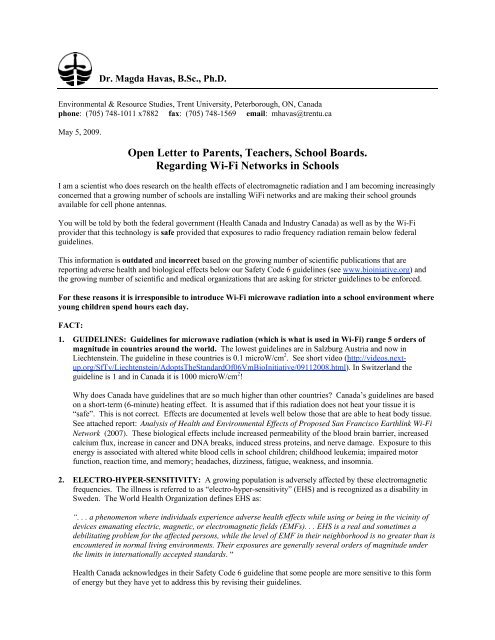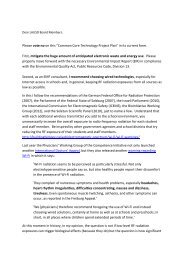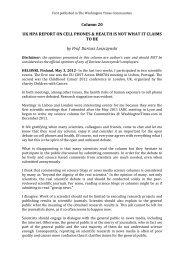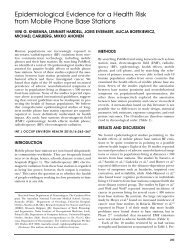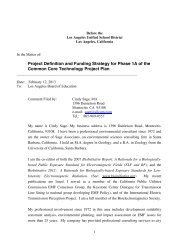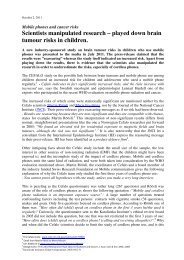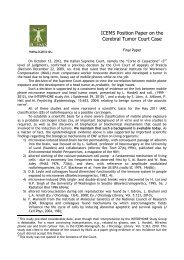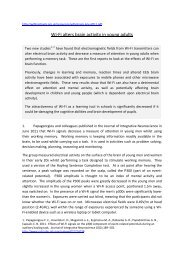Open Letter to Parents, Teachers, School Boards. Regarding Wi-Fi ...
Open Letter to Parents, Teachers, School Boards. Regarding Wi-Fi ...
Open Letter to Parents, Teachers, School Boards. Regarding Wi-Fi ...
You also want an ePaper? Increase the reach of your titles
YUMPU automatically turns print PDFs into web optimized ePapers that Google loves.
Dr. Magda Havas, B.Sc., Ph.D.<br />
Environmental & Resource Studies, Trent University, Peterborough, ON, Canada<br />
phone: (705) 748-1011 x7882 fax: (705) 748-1569 email: mhavas@trentu.ca<br />
May 5, 2009.<br />
<strong>Open</strong> <strong>Letter</strong> <strong>to</strong> <strong>Parents</strong>, <strong>Teachers</strong>, <strong>School</strong> <strong>Boards</strong>.<br />
<strong>Regarding</strong> <strong>Wi</strong>-<strong>Fi</strong> Networks in <strong>School</strong>s<br />
I am a scientist who does research on the health effects of electromagnetic radiation and I am becoming increasingly<br />
concerned that a growing number of schools are installing <strong>Wi</strong><strong>Fi</strong> networks and are making their school grounds<br />
available for cell phone antennas.<br />
You will be <strong>to</strong>ld by both the federal government (Health Canada and Industry Canada) as well as by the <strong>Wi</strong>-<strong>Fi</strong><br />
provider that this technology is safe provided that exposures <strong>to</strong> radio frequency radiation remain below federal<br />
guidelines.<br />
This information is outdated and incorrect based on the growing number of scientific publications that are<br />
reporting adverse health and biological effects below our Safety Code 6 guidelines (see www.bioiniative.org) and<br />
the growing number of scientific and medical organizations that are asking for stricter guidelines <strong>to</strong> be enforced.<br />
For these reasons it is irresponsible <strong>to</strong> introduce <strong>Wi</strong>-<strong>Fi</strong> microwave radiation in<strong>to</strong> a school environment where<br />
young children spend hours each day.<br />
FACT:<br />
1. GUIDELINES: Guidelines for microwave radiation (which is what is used in <strong>Wi</strong>-<strong>Fi</strong>) range 5 orders of<br />
magnitude in countries around the world. The lowest guidelines are in Salzburg Austria and now in<br />
Liechtenstein. The guideline in these countries is 0.1 microW/cm 2 . See short video (http://videos.nextup.org/SfTv/Liechtenstein/AdoptsTheStandardOf06VmBioInitiative/09112008.html).<br />
In Switzerland the<br />
guideline is 1 and in Canada it is 1000 microW/cm 2 !<br />
Why does Canada have guidelines that are so much higher than other countries? Canada’s guidelines are based<br />
on a short-term (6-minute) heating effect. It is assumed that if this radiation does not heat your tissue it is<br />
“safe”. This is not correct. Effects are documented at levels well below those that are able <strong>to</strong> heat body tissue.<br />
See attached report: Analysis of Health and Environmental Effects of Proposed San Francisco Earthlink <strong>Wi</strong>-<strong>Fi</strong><br />
Network (2007). These biological effects include increased permeability of the blood brain barrier, increased<br />
calcium flux, increase in cancer and DNA breaks, induced stress proteins, and nerve damage. Exposure <strong>to</strong> this<br />
energy is associated with altered white blood cells in school children; childhood leukemia; impaired mo<strong>to</strong>r<br />
function, reaction time, and memory; headaches, dizziness, fatigue, weakness, and insomnia.<br />
2. ELECTRO-HYPER-SENSITIVITY: A growing population is adversely affected by these electromagnetic<br />
frequencies. The illness is referred <strong>to</strong> as “electro-hyper-sensitivity” (EHS) and is recognized as a disability in<br />
Sweden. The World Health Organization defines EHS as:<br />
“. . . a phenomenon where individuals experience adverse health effects while using or being in the vicinity of<br />
devices emanating electric, magnetic, or electromagnetic fields (EMFs). . . EHS is a real and sometimes a<br />
debilitating problem for the affected persons, while the level of EMF in their neighborhood is no greater than is<br />
encountered in normal living environments. Their exposures are generally several orders of magnitude under<br />
the limits in internationally accepted standards. “<br />
Health Canada acknowledges in their Safety Code 6 guideline that some people are more sensitive <strong>to</strong> this form<br />
of energy but they have yet <strong>to</strong> address this by revising their guidelines.
Symp<strong>to</strong>ms of EHS include sleep disturbance, fatigue, pain, nausea, skin disorders, problems with eyes and ears<br />
(tinnitus), dizziness, etc. It is estimated that 3% of the population are severely affected and another 35% have<br />
moderate symp<strong>to</strong>ms. Prolonged exposure may be related <strong>to</strong> sensitivity and for this reason it is imperative that<br />
children’s exposure <strong>to</strong> microwave radiation (<strong>Wi</strong>-<strong>Fi</strong> and mobile phones) be minimized as much as possible.<br />
3. CHILDREN’S SENSITIVITY: Children are more sensitive <strong>to</strong> environmental contaminants and that includes<br />
microwave radiation. The Stewart Report (2000) recommended that children not use cell phones except for<br />
emergencies. The cell phone exposes your head <strong>to</strong> microwave radiation. A wireless computer (<strong>Wi</strong>-<strong>Fi</strong>) exposes<br />
your entire upper body and if you have the computer on your lap it exposes your reproductive organs as well.<br />
Certainly this is not desirable, especially for younger children and teenagers. For this reason we need <strong>to</strong><br />
discourage the use of wireless technology by children, especially in elementary schools. That does not mean<br />
that students cannot go on the Internet. It simply means that access <strong>to</strong> the Internet needs <strong>to</strong> be through wires<br />
rather than through the air (wireless, <strong>Wi</strong>-<strong>Fi</strong>).<br />
4. REMOVAL OF WI-FI: Most people do not want <strong>to</strong> live near either cell phone antennas or <strong>Wi</strong>-<strong>Fi</strong> antennas<br />
because of health concerns. Yet when <strong>Wi</strong>-<strong>Fi</strong> (wireless routers) are used inside buildings it is similar <strong>to</strong> the<br />
antenna being inside the building rather than outside and is potentially much worse with respect <strong>to</strong> exposure<br />
since you are closer <strong>to</strong> the source of emission.<br />
Libraries in France are removing <strong>Wi</strong>-<strong>Fi</strong> because of concern from both the scientific community and their<br />
employees and patrons.<br />
The Vancouver <strong>School</strong> Board (VSB) passed a resolution in January 2005 that prohibits construction of cellular<br />
antennas within 1000 feet (305 m) from school property.<br />
Palm Beach, Florida, Los Angeles, California, and New Zealand have all prohibited cell phone base stations and<br />
antennas near schools due <strong>to</strong> safety concerns. The decision not <strong>to</strong> place cell antennas near schools is based on<br />
the likelihood that children are more susceptible <strong>to</strong> this form of radiation. Clearly if we do not want antennas<br />
“near” schools”, we certainly do not want antennas “inside” schools! The safest route is <strong>to</strong> have wired<br />
internet access rather than wireless. While this is the more costly alternative in the short-term it is the least<br />
costly alternative in the long run if we fac<strong>to</strong>r in the cost of ill health of both teachers and students.<br />
5. ADVISORIES: Advisories <strong>to</strong> limit cell phone use have been issued by the various countries and organizations<br />
including the UK (2000), Germany (2007), France, Russia, India, Belgium (2008) as well as the Toron<strong>to</strong> Board<br />
of Health (July 2008) and the Pittsburgh Cancer Institute (July 2008). While these advisories relate <strong>to</strong> cell<br />
phone use, they apply <strong>to</strong> <strong>Wi</strong>-<strong>Fi</strong> exposure as well since both use microwave radiation. If anything, <strong>Wi</strong>-<strong>Fi</strong><br />
computers expose more of the body <strong>to</strong> this radiation than do cell phones.<br />
6. PRECAUTIONARY PRINCIPLE: Even those who do not “accept” the science showing adverse biological<br />
effects of microwave exposure should recognize the need <strong>to</strong> be careful with the health of children. For this<br />
reason we have the Precautionary Principle, which states:<br />
In order <strong>to</strong> protect the environment, the precautionary approach shall be widely applied by States according <strong>to</strong><br />
their capability. Where there are threats of serious or irreversible damage, lack of full scientific certainty shall<br />
not be used as a reason for postponing cost effective measures <strong>to</strong> prevent environmental degradation.<br />
In this case “States” refers <strong>to</strong> the <strong>School</strong> Board and those who make decisions about the health of children.<br />
The two most important environments in a child’s life are the home (especially the bedroom) and the school. For<br />
this reason it is imperative that these environments remain as safe as possible. If we are <strong>to</strong> err, please let us err on<br />
the side of caution.<br />
Respectfully submitted,<br />
Dr. Magda Havas,<br />
Associate Professor<br />
Trent University<br />
May 5, 2009


